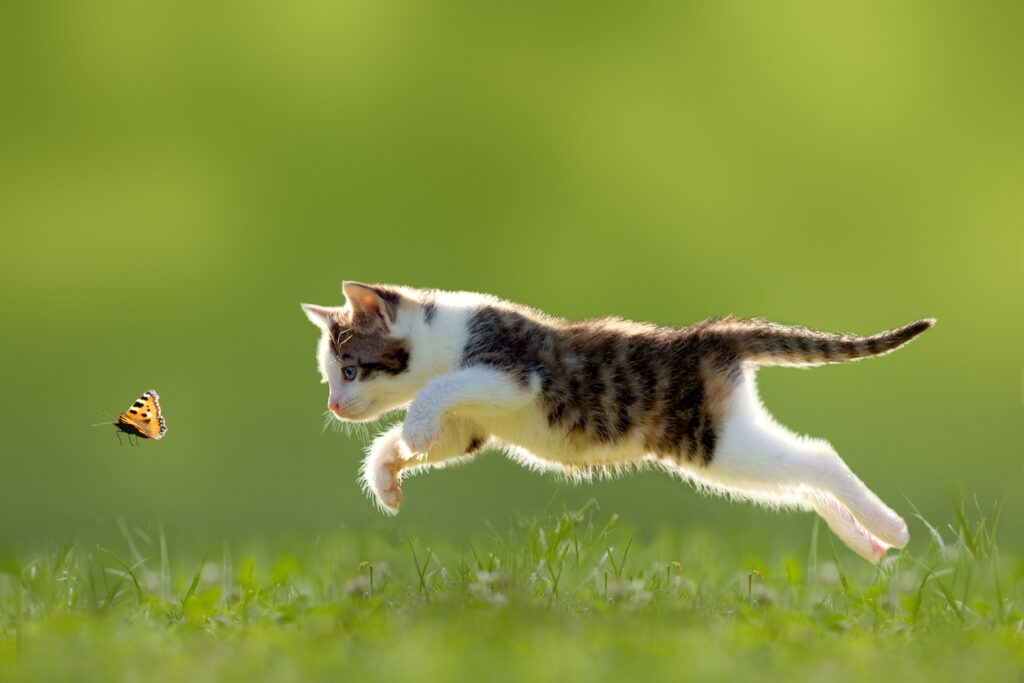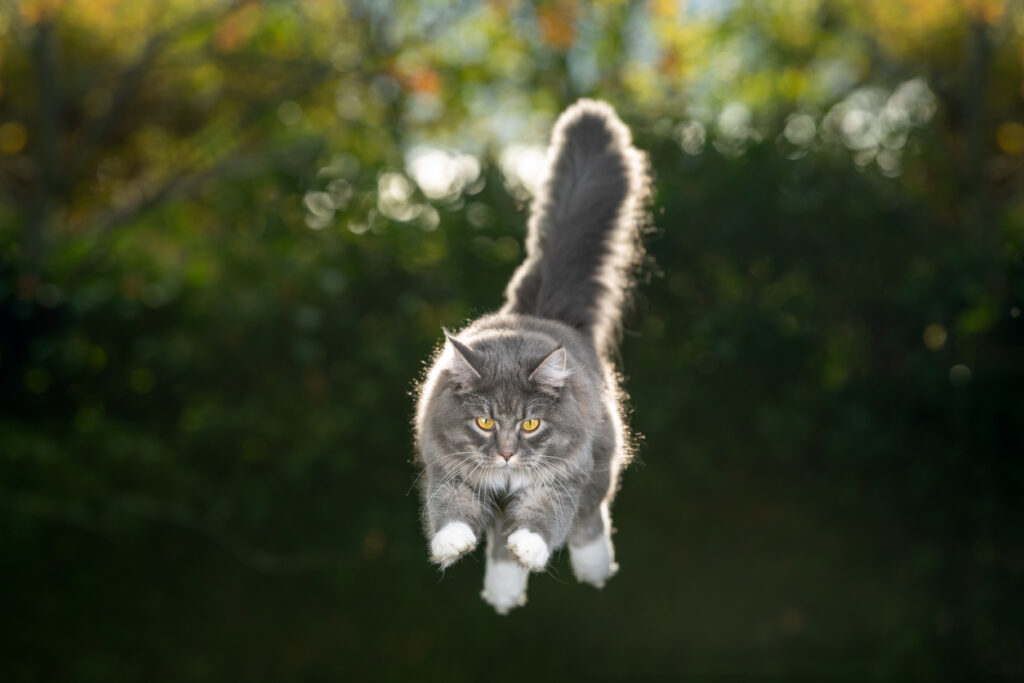We’ve all seen it—cats taking wild leaps off shelves or slipping from ledges, only to twist in midair and land like nothing happened.

Meanwhile, if a dog tumbles, it’s usually a full-body splat, and they can get seriously hurt. (Poor things!) So what gives? How is it that cats truly seem to have nine lives and can fall from great heights without so much as a rough landing? Here’s why cats are built for aerial acrobatics—and why dogs, well, aren’t.
Cats have a built-in “righting reflex.”

Cats are born with something called the righting reflex. It kicks in when they start to fall, allowing them to twist their bodies midair and reorient themselves feet-down, often in a matter of milliseconds. This instinct develops when they’re just a few weeks old and becomes fully functional by around six weeks. Dogs don’t have this automatic response wired in the same way, which is why they can’t self-correct in freefall.
Their flexible spine gives them an edge

A cat’s spine is incredibly bendy. It can twist in ways most animals’ backs can’t, allowing the front half of their body to rotate independently of the back half during a fall. That flexibility is key to pulling off the righting reflex. Dogs have stiffer spines, especially in larger breeds, which limits their ability to twist in midair and reposition themselves before hitting the ground.
Cats are more compact and lightweight.

Cats are small, light, and usually have a low centre of gravity, which helps reduce the force they hit the ground with. Their bodies are built for climbing and leaping, so falling is part of their natural skillset. Dogs come in all sizes, and the bulkier ones don’t have the same aerial agility. More weight and less surface area means more impact—and a lot less control when falling from heights.
They spread out like tiny parachutes.

During a fall, cats instinctively spread their legs and flatten their bodies. This increases air resistance, slowing their descent and giving them more time to adjust before landing. Dogs don’t naturally do this. They tend to stay curled or fall in a less aerodynamic shape, which makes their falls faster and harder. Cats, on the other hand, literally float a bit on the way down.
Cats have super-sensitive balance systems.

A cat’s inner ear—the part responsible for balance—is extra sensitive. It helps them detect tiny shifts in motion and correct their posture almost instantly when they start to fall. This balance system works with their eyes and muscles to coordinate the midair spin. Dogs do have inner ear balance, of course, but it’s not nearly as refined or reaction-based as what cats are working with.
They’ve evolved for climbing and falling.

In the wild, cats are climbers. Whether it’s trees, ledges, or cliffs, their bodies evolved to handle the risks that come with vertical movement, including the occasional fall. Dogs evolved differently. Most breeds are ground-based hunters or herders. They’re great runners, sniffers, and swimmers—but aerial grace? Not really their lane.
Cats rotate in a very specific way.

During a fall, cats first turn their head, then their front legs, then their spine and back legs. It’s a precise sequence that lets them twist 180 degrees without needing to push off anything. Dogs don’t have that level of segmental control. Their bodies tend to move as one unit, making it harder to rotate efficiently or realign themselves in midair.
Their legs act like natural shock absorbers.

When cats land, they bend their legs deeply to absorb the shock. Their joints act like suspension systems, spreading out the impact and preventing injury, even from surprisingly high falls. Dogs, especially bigger breeds, don’t have the same joint flexibility. They hit the ground more stiffly, which can lead to injury or awkward landings even from low heights.
Cats can survive falls from scary heights.

There’s actually a name for it—“high-rise syndrome.” It’s been observed in cats that survive falls from multi-story buildings. Once they reach a certain height, they seem to stabilise midair and land with less harm than expected. Dogs simply don’t have that luxury. Falls from even moderate heights can lead to broken bones or worse. They don’t have the right mix of flexibility, control, and shock absorption to pull it off.
Their instincts are sharper in the air.

When cats fall, they don’t panic—they correct. Their bodies shift into survival mode almost instantly, and every muscle cooperates to pull off the save. It’s graceful, precise, and honestly kind of amazing to watch. Dogs, however, tend to flail. Their natural instincts don’t include fine-tuned midair corrections. They’re great at reacting to things on the ground, but once they’re airborne, there’s not much they can do until gravity finishes the job.
Cats have longer “airtime” to adjust.

Because of their body shape and spread-out posture, cats fall slower than you’d expect. That extra bit of airtime gives them the chance to finish the spin, adjust their limbs, and brace for landing. Dogs fall faster and heavier. Without the same level of control or time to react, they hit the ground harder and less gracefully—if they’re lucky enough to land on their feet at all.
One is built for leaping—one’s built for loyalty.

In the end, it’s about design. Cats are built for agility, stealth, and vertical living. Everything from their spine to their reflexes makes them natural acrobats. Dogs are built for connection, protection, and working alongside humans on the ground.
So if your dog trips over a step and your cat survives a fall from the wardrobe, it’s not about who’s smarter—it’s just biology doing its thing. Cats might win the landing game, but dogs are still the ones who come running when you call.